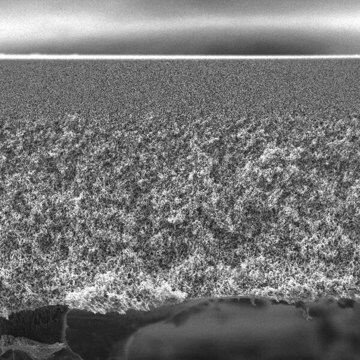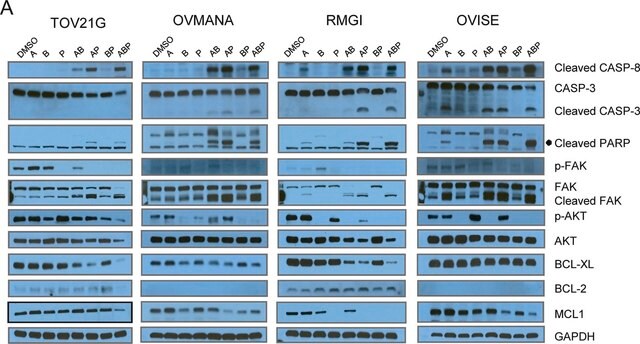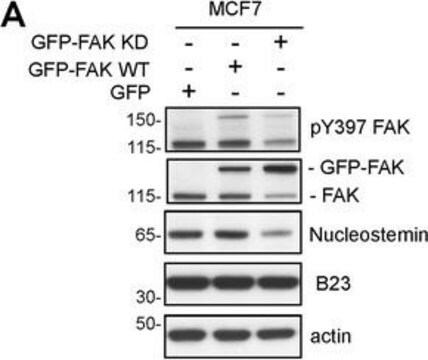推荐产品
生物源
rabbit
品質等級
抗體表格
affinity purified immunoglobulin
抗體產品種類
primary antibodies
無性繁殖
polyclonal
純化經由
affinity chromatography
物種活性
human
製造商/商標名
Upstate®
技術
immunohistochemistry: suitable (paraffin)
western blot: suitable
同型
IgG
NCBI登錄號
UniProt登錄號
運輸包裝
dry ice
目標翻譯後修改
unmodified
基因資訊
human ... FADD(8772)
一般說明
FAS-associated death domain protein (UniProt: Q13158; also known as FAS-associating death domain-containing protein, Growth-inhibiting gene 3 protein, Mediator of receptor induced toxicity, Protein FADD) is encoded by the FADD (also known as MORT1, GIG3) gene (Gene ID: 8772) in human. FADD is an apoptotic adaptor molecule that bridges death receptor signaling to the caspase cascade. It is expressed in a wide variety of tissues, except for peripheral blood mononuclear leukocytes. FADD contains a death domain at its C-terminus and a death effector domain (DED) at its N-terminal. The death domain is responsible for FADD binding to the activated trimerized Fas receptor. FADD recruits procaspase-8 through its N-terminal DED, which is then activated following the cleavage of pro domain. The death inducing signaling complex (DISC) formed by Fas receptor, FADD, and caspase-8 is essential in triggering apoptotic events in cells. Human FADD is phosphorylated mainly at Ser194. Defects in FADD gene have been linked to recurrent infections, hepatic dysfunction, and cardiovascular malformations. These subjects display high circulating levels of CD4(-) and CD8(-) cells and elevated levels of IL-10.
特異性
This polyclonal antibody detects FADD protein in human cells.
免疫原
His-tagged full-length human recombinant FAS-associated death domain protein.
應用
Detect FAS-associated death domain protein using this rabbit polyclonal Anti-FADD, Cat. No. 06-711. It has been tested for use in Immunohistochemistry (Paraffin) and Western Blotting.
Immunohistochemistry Analysis: A 1:250 dilution of this antibody detected FADD in human pancreas, human kidney, and human prostate tissue.
Research Category
Apoptosis & Cancer
Apoptosis & Cancer
Research Sub Category
Apoptosis - Additional
Apoptosis - Additional
品質
Evaluated by Western Blotting in Jurkat cell lysate.
Western Blotting Analysis: 0.2 µg/mL of this antibody detected FADD in 10 µg of Jurkat cell lysate.
Western Blotting Analysis: 0.2 µg/mL of this antibody detected FADD in 10 µg of Jurkat cell lysate.
標靶描述
~26 kDa observed; 23.28 kDa calculated. Uncharacterized bands may be observed in some lysate(s).
聯結
Replaces: 04-1113
外觀
ImmunoAffinity Purified
Purified rabbit polyclonal antibody in buffer containing 0.1 M Tris-Glycine (pH 7.4), 150 mM NaCl with 0.05% sodium azide.
儲存和穩定性
Stable for 1 year at 2-8°C from date of receipt.
分析報告
Control
Positive Antigen Control: Catalog #12-303, Jurkat cell lysate.
Positive Antigen Control: Catalog #12-303, Jurkat cell lysate.
其他說明
Concentration: Please refer to lot specific datasheet.
法律資訊
UPSTATE is a registered trademark of Merck KGaA, Darmstadt, Germany
免責聲明
Unless otherwise stated in our catalog or other company documentation accompanying the product(s), our products are intended for research use only and are not to be used for any other purpose, which includes but is not limited to, unauthorized commercial uses, in vitro diagnostic uses, ex vivo or in vivo therapeutic uses or any type of consumption or application to humans or animals.
未找到合适的产品?
试试我们的产品选型工具.
儲存類別代碼
12 - Non Combustible Liquids
水污染物質分類(WGK)
WGK 1
閃點(°F)
Not applicable
閃點(°C)
Not applicable
Molecular determinants of kinase pathway activation by Apo2 ligand/tumor necrosis factor-related apoptosis-inducing ligand.
Varfolomeev, E; Maecker, H; Sharp, D; Lawrence, D; Renz, M; Vucic, D; Ashkenazi, A
The Journal of Biological Chemistry null
Xin Xu et al.
Cell death & disease, 11(2), 94-94 (2020-02-07)
Adult T-cell leukemia/lymphoma (ATLL) is a malignancy of mature T cells associated with chronic infection by human T-cell lymphotropic virus type-1 (HTLV-1). ATLL patients with aggressive subtypes have dismal outcomes. We demonstrate that ATLL cells co-opt an early checkpoint within
Teruki Yanagi et al.
PloS one, 10(3), e0119404-e0119404 (2015-03-20)
While PCTAIRE1/PCTK1/Cdk16 is overexpressed in malignant cells and is crucial in tumorigenesis, its function in apoptosis remains unclear. Here we investigated the role of PCTAIRE1 in apoptosis, especially in the extrinsic cell death pathway. Gene-knockdown of PCTAIRE1 sensitized prostate cancer
Peifeng Li et al.
The Journal of biological chemistry, 285(29), 22713-22722 (2010-05-21)
MADD plays an essential role in cancer cell survival. Abrogation of endogenous MADD expression results in significant spontaneous apoptosis and enhanced susceptibility to tumor necrosis factor alpha-related apoptosis-inducing ligand (TRAIL)-induced apoptosis. However, the regulation of MADD function is largely unknown.
Mélanie Simoes Eugénio et al.
Frontiers in molecular biosciences, 8, 645134-645134 (2021-05-04)
Tumor necrosis factor-related apoptosis-inducing ligand (TRAIL) is a well-known apoptosis inducer and a potential anticancer agent. When caspases and inhibitors of apoptosis proteins (IAPs) are inhibited, TRAIL induces necroptosis. Molecular mechanisms of necroptosis rely on kinase activation, and on the
我们的科学家团队拥有各种研究领域经验,包括生命科学、材料科学、化学合成、色谱、分析及许多其他领域.
联系技术服务部门








